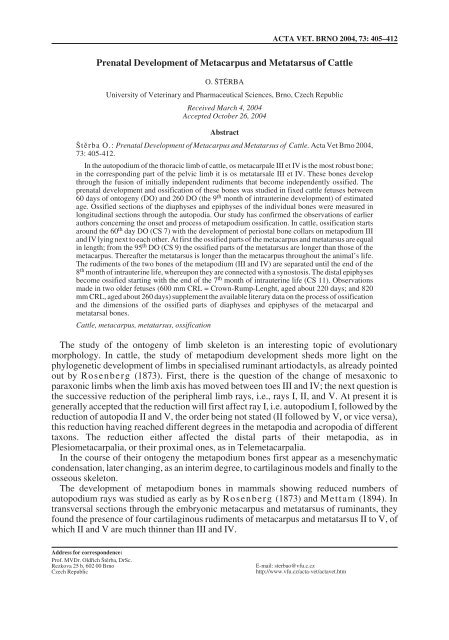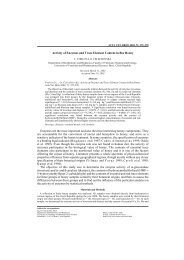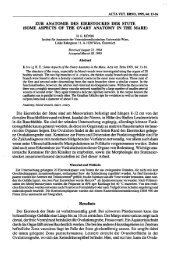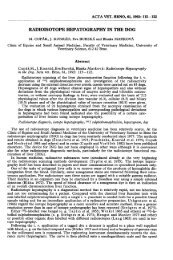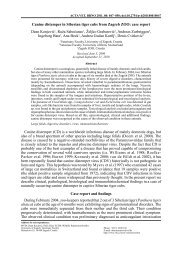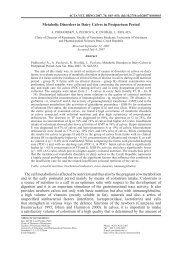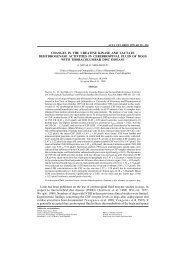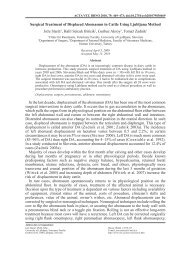Prenatal Development of Metacarpus and Metatarsus of Cattle
Prenatal Development of Metacarpus and Metatarsus of Cattle
Prenatal Development of Metacarpus and Metatarsus of Cattle
You also want an ePaper? Increase the reach of your titles
YUMPU automatically turns print PDFs into web optimized ePapers that Google loves.
ACTA VET. BRNO 2004, 73: 405–412<br />
<strong>Prenatal</strong> <strong>Development</strong> <strong>of</strong> <strong>Metacarpus</strong> <strong>and</strong> <strong>Metatarsus</strong> <strong>of</strong> <strong>Cattle</strong><br />
O. ·TùRBA<br />
University <strong>of</strong> Veterinary <strong>and</strong> Pharmaceutical Sciences, Brno, Czech Republic<br />
Received March 4, 2004<br />
Accepted October 26, 2004<br />
Abstract<br />
·tûrba O.: <strong>Prenatal</strong> <strong>Development</strong> <strong>of</strong> <strong>Metacarpus</strong> <strong>and</strong> <strong>Metatarsus</strong> <strong>of</strong> <strong>Cattle</strong>. Acta Vet Brno 2004,<br />
73: 405-412.<br />
In the autopodium <strong>of</strong> the thoracic limb <strong>of</strong> cattle, os metacarpale III et IV is the most robust bone;<br />
in the corresponding part <strong>of</strong> the pelvic limb it is os metatarsale III et IV. These bones develop<br />
through the fusion <strong>of</strong> initially independent rudiments that become independently ossified. The<br />
prenatal development <strong>and</strong> ossification <strong>of</strong> these bones was studied in fixed cattle fetuses between<br />
60 days <strong>of</strong> ontogeny (DO) <strong>and</strong> 260 DO (the 9 th month <strong>of</strong> intrauterine development) <strong>of</strong> estimated<br />
age. Ossified sections <strong>of</strong> the diaphyses <strong>and</strong> epiphyses <strong>of</strong> the individual bones were measured in<br />
longitudinal sections through the autopodia. Our study has confirmed the observations <strong>of</strong> earlier<br />
authors concerning the onset <strong>and</strong> process <strong>of</strong> metapodium ossification. In cattle, ossification starts<br />
around the 60 th day DO (CS 7) with the development <strong>of</strong> periostal bone collars on metapodium III<br />
<strong>and</strong> IV lying next to each other. At first the ossified parts <strong>of</strong> the metacarpus <strong>and</strong> metatarsus are equal<br />
in length; from the 95 th DO (CS 9) the ossified parts <strong>of</strong> the metatarsus are longer than those <strong>of</strong> the<br />
metacarpus. Thereafter the metatarsus is longer than the metacarpus throughout the animal’s life.<br />
The rudiments <strong>of</strong> the two bones <strong>of</strong> the metapodium (III <strong>and</strong> IV) are separated until the end <strong>of</strong> the<br />
8 th month <strong>of</strong> intrauterine life, whereupon they are connected with a synostosis. The distal epiphyses<br />
become ossified starting with the end <strong>of</strong> the 7 th month <strong>of</strong> intrauterine life (CS 11). Observations<br />
made in two older fetuses (600 mm CRL = Crown-Rump-Lenght, aged about 220 days; <strong>and</strong> 820<br />
mm CRL, aged about 260 days) supplement the available literary data on the process <strong>of</strong> ossification<br />
<strong>and</strong> the dimensions <strong>of</strong> the ossified parts <strong>of</strong> diaphyses <strong>and</strong> epiphyses <strong>of</strong> the metacarpal <strong>and</strong><br />
metatarsal bones.<br />
<strong>Cattle</strong>, metacarpus, metatarsus, ossification<br />
The study <strong>of</strong> the ontogeny <strong>of</strong> limb skeleton is an interesting topic <strong>of</strong> evolutionary<br />
morphology. In cattle, the study <strong>of</strong> metapodium development sheds more light on the<br />
phylogenetic development <strong>of</strong> limbs in specialised ruminant artiodactyls, as already pointed<br />
out by Rosenberg (1873). First, there is the question <strong>of</strong> the change <strong>of</strong> mesaxonic to<br />
paraxonic limbs when the limb axis has moved between toes III <strong>and</strong> IV; the next question is<br />
the successive reduction <strong>of</strong> the peripheral limb rays, i.e., rays I, II, <strong>and</strong> V. At present it is<br />
generally accepted that the reduction will first affect ray I, i.e. autopodium I, followed by the<br />
reduction <strong>of</strong> autopodia II <strong>and</strong> V, the order being not stated (II followed by V, or vice versa),<br />
this reduction having reached different degrees in the metapodia <strong>and</strong> acropodia <strong>of</strong> different<br />
taxons. The reduction either affected the distal parts <strong>of</strong> their metapodia, as in<br />
Plesiometacarpalia, or their proximal ones, as in Telemetacarpalia.<br />
In the course <strong>of</strong> their ontogeny the metapodium bones first appear as a mesenchymatic<br />
condensation, later changing, as an interim degree, to cartilaginous models <strong>and</strong> finally to the<br />
osseous skeleton.<br />
The development <strong>of</strong> metapodium bones in mammals showing reduced numbers <strong>of</strong><br />
autopodium rays was studied as early as by Rosenberg (1873) <strong>and</strong> Mettam (1894). In<br />
transversal sections through the embryonic metacarpus <strong>and</strong> metatarsus <strong>of</strong> ruminants, they<br />
found the presence <strong>of</strong> four cartilaginous rudiments <strong>of</strong> metacarpus <strong>and</strong> metatarsus II to V, <strong>of</strong><br />
which II <strong>and</strong> V are much thinner than III <strong>and</strong> IV.<br />
Address for correspondence:<br />
Pr<strong>of</strong>. MVDr. Oldfiich ·tûrba, DrSc.<br />
Rezkova 25 b, 602 00 Brno<br />
Czech Republic<br />
E-mail: sterbao@vfu.c.cz<br />
http://www.vfu.cz/acta-vet/actavet.htm
406<br />
In embryos CRL 30 <strong>and</strong> 42 mm, Petersen (1922) found cartilaginous models <strong>of</strong><br />
autopodia, the major metacarpus <strong>and</strong> metatarsus being equal in length (4 <strong>and</strong> 5 mm<br />
respectively). From embryo CRL 50 mm onwards the metatarsi begin to be longer (6 <strong>and</strong> 7<br />
mm). In a fetus CRL 66 mm the author observed perichondral ossification <strong>of</strong> the diaphyses<br />
<strong>of</strong> metapodia III <strong>and</strong> IV, while that <strong>of</strong> the metapodia II <strong>and</strong> V was somewhat delayed. The<br />
metatarsi were longer (11 mm) than the metacarpi (10 mm). In fetuses CRL 92 mm <strong>and</strong> 95<br />
mm all four metacarpi <strong>and</strong> metatarsi showed ossification, as confirmed by staining with<br />
alizarin red. The main metacarpi were 17 mm, the metatarsi 18 mm long. These observations<br />
were confirmed by Martin (1912) in a fetus CRL 100 mm. Fetuses CRL 115 <strong>and</strong> 125 mm<br />
show successive reduction <strong>of</strong> metacarpus <strong>and</strong> metatarsus II <strong>and</strong> V. <strong>Metacarpus</strong> II is only<br />
preserved in its distal section, metacarpus V divides into a proximal <strong>and</strong> a distal part.<br />
<strong>Metatarsus</strong> II has been completely resorbed, <strong>and</strong> only the proximal part remains <strong>of</strong><br />
metatarsus V. In a fetus CRL 135 mm only the proximal part <strong>of</strong> metacarpus V has been<br />
preserved, ossifying in the proximal direction, whereas metacarpus II, metatarsus II <strong>and</strong><br />
metatarsus V have disappeared. The main metacarpi are 28 mm, the metatarsi 34 mm in<br />
length. A fetus CRL 420 mm (178 DO) already shows advanced ossification, its metacarpi<br />
III <strong>and</strong> IV being 47 mm, metatarsi III <strong>and</strong> IV 51 mm long. Its metacarpus V is 7 mm long.<br />
Küpfer <strong>and</strong> Schinz (1923) stated that the bones <strong>of</strong> the metapodium would develop from<br />
an initially five-rayed prechondral rudiment. The onset <strong>of</strong> ossification <strong>of</strong> diaphyses III <strong>and</strong><br />
IV <strong>of</strong> the metapodium was demonstrated by these authors using the x-ray method in fetuses<br />
in the 9th week <strong>of</strong> intrauterine development (i.e. 57-63 DO) at CRL 82 mm.<br />
Using the same method, Gjesdal (1969) also demonstrated the onsets <strong>of</strong> ossification <strong>of</strong><br />
metacarpi <strong>and</strong> metatarsi III <strong>and</strong> IV in fetuses <strong>of</strong> various cattle breeds at the age <strong>of</strong> 61-65 DO,<br />
i.e. two months, when the ossified diaphyses were 2 mm long. From the age <strong>of</strong> 76-80 DO to<br />
96-100 DO onwards the metatarsus is invariably longer by l mm (l0 <strong>and</strong> 11 mm<br />
respectively); from the age <strong>of</strong> 101-105 DO to 131-135 DO this difference increases up to<br />
3 mm (23 vs. 26 mm), <strong>and</strong> at the age <strong>of</strong> 136-140 DO the difference is 6 mm (24 vs. 30 mm).<br />
In the distal epiphysis, the presence <strong>of</strong> ossification centres can be demonstrated from the<br />
7th month <strong>of</strong> intrauterine development (fetus 727 mm) (Küpfer <strong>and</strong> Schinz 1923;<br />
Gjesdal 1969). Ossification continues in the diaphysis <strong>and</strong> distal epiphysis, still divided by<br />
a cartilaginous epiphysal plate; according to Kolda (1936), this plate becomes ossified at<br />
the age <strong>of</strong> 2-2.5 years, thus causing the epiphysis to fuse with the diaphysis. Using the x-ray<br />
method <strong>and</strong> staining with alizarin red, âerven˘ (1980) still found remains <strong>of</strong> an epiphysal<br />
cartilage in the metapodium <strong>of</strong> a bull 20 months <strong>of</strong> age.<br />
According to Kolda (1936), in the metapodium <strong>of</strong> newborns it is still possible to separate<br />
the two initially independent bones (III <strong>and</strong> V). Küpfer <strong>and</strong> Schinz (1923) observed in<br />
their x-ray photographs that starting from 9 weeks <strong>of</strong> age (about 65 DO, CRL 82 mm) until<br />
6 months <strong>of</strong> intrauterine development (CRL 520 mm), the ossified diaphyses <strong>of</strong> metapodia<br />
III <strong>and</strong> IV are still independent. In fetuses CRL 570 <strong>and</strong> 580 mm from the same month, the<br />
ossified diaphyses are in close contact, the same as in a fetus CRL 727 mm (end <strong>of</strong> the 7th<br />
month) where even the distal epiphyses begin to be ossified.<br />
Regli (1963) states that the osseous connection between metapodia III <strong>and</strong> IV begins<br />
developing in the proximal-distal direction from 200 DO onwards, to end around the 210 th<br />
day. The epiphyses become fused at the age <strong>of</strong> 2.5-3 years.<br />
The prenatal development <strong>and</strong> growth <strong>of</strong> the skeleton <strong>of</strong> cattle autopodium was also<br />
studied by âerven˘ (1983, 1985a, 1985b) <strong>and</strong> âerven˘ <strong>and</strong> Páral (1994) who discussed<br />
the development <strong>of</strong> sesamoid bones which are parts <strong>of</strong> the skeleton <strong>of</strong> the autopodium. Using<br />
dissection, x-ray imaging, sections stained with alizarin red, <strong>and</strong> macerated material, the<br />
authors showed the time sequence <strong>of</strong> development <strong>of</strong> ossification centres <strong>of</strong> these bones,<br />
their morphological characteristics as well as sex-dependent differences.
407<br />
Fig. 1. Process <strong>of</strong> ossification <strong>of</strong> metacarpal bones. Solid line – length; dotted line – width. Correlation <strong>of</strong> two<br />
variables.<br />
Fig. 2. Process <strong>of</strong> ossification <strong>of</strong> metatarsal bones. Solid line – length; dotted line – width. Correlation <strong>of</strong> two<br />
variables.<br />
To create a complete idea <strong>of</strong> the developing skeleton, Páral <strong>and</strong> Mí‰ek (1994) described<br />
the mineralization process <strong>of</strong> the bovine metatarsus during the period from 240 to 280 DO.<br />
They demonstrated a general increase in the ash content <strong>of</strong> the bone tissue <strong>and</strong> an increase<br />
in the levels <strong>of</strong> Ca, P, <strong>and</strong> Mg in the growth plate in the course <strong>of</strong> the study period.<br />
The available literary sources, however, do not provide sufficient information on the<br />
ossification process, i.e., the sizes <strong>of</strong> the ossified sections <strong>of</strong> the metapodium diaphyses <strong>and</strong><br />
epiphyses in more advanced fetuses before parturition.
408<br />
Materials <strong>and</strong> Methods<br />
Earlier studies <strong>of</strong> the ontogeny <strong>of</strong> the autopodium skeleton employed the method <strong>of</strong> preparing microscopic slides<br />
<strong>and</strong> their subsequent staining (see Rosenberg 1873; Mettam 1894), which is time-consuming <strong>and</strong> requires much<br />
material. The development <strong>of</strong> x-ray technique naturally lead to the introduction <strong>of</strong> this technique into the present<br />
branch <strong>of</strong> science (see Küpfer <strong>and</strong> Schinz 1923; Regli 1963; âerven˘ et al. l987 <strong>and</strong> many others). Another<br />
method used here was the imaging <strong>of</strong> the ossified sections <strong>of</strong> whole bones or their macroscopic sections stained<br />
with alizarin red. Having obtained good experience in imaging the advancing ossification as well as in staining<br />
whole fetuses, we have employed this method in the present study.<br />
The present paper is based on fixed fetuses from the collections <strong>of</strong> the Department <strong>of</strong> Anatomy, Histology <strong>and</strong><br />
Embryology, Faculty <strong>of</strong> Veterinary Medicine <strong>of</strong> the Veterinary <strong>and</strong> Pharmaceutical University in Brno. By their<br />
CRL <strong>and</strong> external characters the fetuses were classified in comparable developmental stages (Comparable Stages,<br />
CS), <strong>and</strong> their ontogenetic age (Estimated Age, EA) on days <strong>of</strong> ontogeny (DO) was determined using the following<br />
table (see ·tûrba 1987, 1995 for particulars).<br />
Stage Characteristics CRL, mm EA – DO<br />
7 Fusion <strong>of</strong> eyelids, umbilical 50 – 70 56 – 65<br />
hernia reposited)<br />
8 Numerous skinfolds present 80 – 120 75 – 90<br />
9 Tactile hairs on upper lip 130 – 250 95 – 120<br />
10 First fine hairs on body 250 – 380 140 – 215<br />
11 Eyelids separated 390 – 470 160 – 173<br />
12 Dense long hairs on body 560 – 850 210 – 270<br />
Autopodia (left) removed from fixed fetuses were longitudinally cut with a scalpel along the lateral-medial<br />
plane, so that each bone (or bone rudiment) was divided into a dorsal <strong>and</strong> a palmar half. The bones <strong>of</strong> smallersized<br />
fetuses were stained with alizarin red <strong>and</strong> subsequently cleared, using the modification <strong>of</strong> âerven˘<br />
(1971). In fetuses 210 DO <strong>and</strong> older the differentiation method <strong>of</strong> staining bone sections with alizarin red was<br />
used (âerven˘ 1979). The dimensions <strong>of</strong> the ossified sections <strong>of</strong> bone rudiments were measured with<br />
a calliper rule.<br />
Results<br />
The following facts were observed on the fetal autopodia stained with alizarin red <strong>and</strong><br />
subsequently cleared (Plate I, Figs 3, 4):<br />
Fetus CRL = 68 mm, age about 60 DO, W = 14 g, CS 7 (No. 21/1): No signs <strong>of</strong> ossification<br />
were safely demonstrated in the cartilaginous rudiments <strong>of</strong> metapodia.<br />
Fetus CRL = 120 mm, age about 80 DO, W = 76 g, CS 8 (No. 68/4): The cartilaginous<br />
rudiments <strong>of</strong> metapodia show ossifying diaphyses, with a distinct connective tissue between<br />
them. The ossified sections <strong>of</strong> os metacarpale III et IV are 9 mm long, both diaphyses being<br />
3 mm wide (Fig. 1). The ossified sections <strong>of</strong> <strong>of</strong> metacarpale III et IV are also 9 mm long, the<br />
diaphyses are 2 mm wide. No medullar cavities can be discerned. The distal epiphyses are<br />
still cartilaginous; ossification centres are already visible in digital phalanxes.<br />
Fetus CRL = 173 mm, age about 95–100 DO, W = 268 g, CS 9 (No. 29/2): Rudimentary<br />
diaphyses undergo ossification. The ossified sections <strong>of</strong> ossa metacarpalia III et IV are 12<br />
mm long <strong>and</strong> 4 mm wide; those <strong>of</strong> ossa metatarsalia III et IV are 13 mm long <strong>and</strong> 3 mm wide.<br />
The ossified sections are independent, separated by a thin connective strip; no medullar<br />
cavities were observed. The distal epiphyses are still cartilaginous.<br />
Fetus CRL = 222 mm, age about 112 DO, W = 564 g, CS 9 (No. 122/10): The ossified<br />
sections <strong>of</strong> diaphyses <strong>of</strong> metacarpals III <strong>and</strong> IV are 18 mm long <strong>and</strong> 5 mm wide, those <strong>of</strong><br />
metatarsals III <strong>and</strong> IV are 20 mm long <strong>and</strong> 4 mm wide. The bones are still independent,<br />
separated by a thin connective strip; the diaphyses show developing medullar cavities. The<br />
whole epiphyses are still cartilaginous all over.<br />
Fetus CRL = 270 mm, age about 125 DO, W = 1 092 g, CS 10-11? (No. 120/10): The<br />
ossified sections <strong>of</strong> diaphyses <strong>of</strong> os metacarpale III et IV are 29 mm long <strong>and</strong> 7 mm wide,<br />
those <strong>of</strong> os metacarpale III et IV are 30 mm long <strong>and</strong> 6 mm wide. They are still separated by<br />
a thin, continuous connective strip. There are distinct medullar cavities. Ossification centres
409<br />
appear in distal epiphyses. In os metacarpale III et IV they are 3 mm in cross-section, in os<br />
metatarsale III et IV 1 mm only.<br />
Fetus CRL = 325 mm, age about 140 DO, W = 1 540 g, CS 10 (No. 123/10): The diaphyses<br />
<strong>of</strong> os metacarpale III et IV are ossified in a section 24 mm long <strong>and</strong> 7 mm wide, those <strong>of</strong> os<br />
metatarsale III et IV are 29 mm long <strong>and</strong> 6 mm wide. The connective dissepiment between<br />
the ossified bones is more distinct proximally <strong>and</strong> distally. The epiphyses are cartilaginous.<br />
Fetus CRL = 340 mm, age about 147 DO, W = 2 260 g, CS 10 (No. 125): The total length<br />
<strong>of</strong> the rudimentary skeleton <strong>of</strong> os metacarpale III et IV is 48 mm, that <strong>of</strong> os metatarsale III<br />
et IV is 54 mm. The ossified parts <strong>of</strong> the diaphyses in os metacarpale III et IV are 33 mm<br />
long <strong>and</strong> 8 mm wide (Plate I, Fig. 2), those <strong>of</strong> os metatarsale III et IV are 37 mm long <strong>and</strong> 7<br />
mm wide. There is a thin, 0.5 mm wide connective strip between the two bones. No onset <strong>of</strong><br />
ossification can be observed in the epiphyses.<br />
Fetus CRL = 360 mm, age about 152 DO, W = 2 820 g, CS 10 (No. 129): The total length<br />
<strong>of</strong> the rudimentary skeleton <strong>of</strong> os metacarpale III et IV is 51 mm, the ossified sections <strong>of</strong> the<br />
diaphyses are 35 mm long <strong>and</strong> 10 mm wide. The skeleton rudiment <strong>of</strong> os metatarsale III et<br />
IV is 58 mm in total length <strong>and</strong> 9 mm in width. There is a connective strip, 0.5 mm wide,<br />
between the ossified sections. The epiphyses are cartilaginous.<br />
Fetus CRL = 600 mm, age about 210 DO, W = 14 000 g, CS 11 (no number): The total<br />
length <strong>of</strong> the rudimentary skeleton <strong>of</strong> os metacarpale III et IV is 112 mm, the rudimentary<br />
diaphyses are 94 mm long, their ossified sections are 88 mm long <strong>and</strong> 17 mm wide. The<br />
skeleton rudiment <strong>of</strong> os metatarsale III et IV is 127 mm in total length, the rudimentary<br />
diaphyses are 108 mm long <strong>and</strong> their ossified sections are 103 mm long <strong>and</strong> 16 mm wide<br />
(Plate II, Fig. 5). The connective dissepiment between the bones is very thin, slightly<br />
widened proximally <strong>and</strong> distally. Ossification also takes place in epiphyses. The epiphysal<br />
rudiments, 18 mm in length, <strong>of</strong> os metacarpale III et IV contain distinct ossification centres<br />
<strong>of</strong> bone tissue, 12 mm in cross-section. The epiphysal rudiments, 19 mm in length, <strong>of</strong> os<br />
metatarsalis III et IV contain ossifications centres 11 mm in cross-section.<br />
Fetus CRL = 820 mm, age about 250 DO, W = 25 000 g, CS 11 (no number): The total length<br />
<strong>of</strong> the rudimentary skeleton <strong>of</strong> os metacarpale III et IV is 147 mm long, the rudimentary<br />
diaphysis is 120 mm long. Its ossified part is 118 mm long <strong>and</strong> 18 mm wide (Plate II, Fig. 6).<br />
Medullar cavities are separated by an osseous dissepiment, a vestige <strong>of</strong> the connective strip<br />
being still present in the distal part. The rudimentary epiphyses are 27 mm, their ossified sections<br />
are 24 mm long. The total length <strong>of</strong> the rudimentary os metatarsale III et IV is 160 mm, the<br />
diaphysis is 134 mm long. Its ossified part is 132 mm long <strong>and</strong> 17 mm wide. Here, too, the<br />
medullar cavities are separated by an osseous dissepiment with a vestigial connective strip in<br />
the distal part. The rudimentary epiphyses are 26 mm, their ossified parts are 23 mm long.<br />
We demonstrated that the synostotic fusion <strong>of</strong> bones III <strong>and</strong> IV in both the metacarpus <strong>and</strong><br />
the metatarsus will take place in the 9th month <strong>of</strong> intrauterine development <strong>of</strong> the fetus.<br />
Hence, the two bones cannot be separated after parturition.<br />
Discussion<br />
We have taken it for necessary to verify <strong>and</strong> compare the data provided by various authors<br />
(Rosenberg 1873; Mettam 1895; Petersen 1922; Küpfer <strong>and</strong> Schinz 1923; Regli<br />
1963; Gjesdal 1969, <strong>and</strong> others) on the process <strong>of</strong> metapodium ossification. Our own<br />
comparable data were obtained from 10 fetuses from 68 to 820 mm CRL, at estimated ages<br />
from 60 to 250 day DO. Their metapodia were stained with alizarin red (âerven˘ 1979).<br />
We found no essential differences from the data reported by the above authors.<br />
Petersen (1922) found the onset <strong>of</strong> ossification in a fetus CRL 66 mm, which<br />
corresponds to the age around 66 days. Küpfer <strong>and</strong> Schinz (1923) place the onset <strong>of</strong><br />
ossification <strong>of</strong> the diaphyses <strong>of</strong> metapodia III <strong>and</strong> IV at the 9 th week <strong>of</strong> ontogeny (57-63
410<br />
days), <strong>and</strong> Gjesdal (1969) provided x-ray evidence <strong>of</strong> the beginning ossification <strong>of</strong><br />
metapodia III <strong>and</strong> IV in fetuses <strong>of</strong> various cattle breeds at the age <strong>of</strong> 61-65 DO. On the basis<br />
<strong>of</strong> his material <strong>and</strong> measurements, Regli (1963) states that the metapodia begin ossifying<br />
on the 68 th day <strong>of</strong> ontogeny at the latest. At first the ossified sections are equal in length – 2<br />
<strong>and</strong> 3 mm – in the metacarpals <strong>and</strong> metatarsals, which situation persists until 80 DO. In our<br />
material we found, in a fetus 121 mm CRL, estimated age 80 DO, ossified sections 9 mm<br />
long in the cartilaginous rudiments <strong>of</strong> diaphyses <strong>of</strong> ossa metacarpalia III et IV as well as ossa<br />
metatarsalia III. et IV. In all cases examined, the process took place in CS 7, in fetuses CRL<br />
80-120 mm, <strong>and</strong> at the age <strong>of</strong> 75-90 DO.<br />
Henceforward the lengths <strong>of</strong> the ossified sections begin to differ in the metacarpals from<br />
those in the metatarsals. They are shorter in the metacarpals, this differences increasing in<br />
the course <strong>of</strong> intrauterine development (Regli l.c.; Gjesdal l.c.). At first the differences<br />
are 1 mm, as found in fetuses CRL 150-180 mm, at 85-100 days <strong>of</strong> estimated age, when the<br />
ossified sections are 8-12 mm long in the metacarpals, as compared to those 9-13 mm long<br />
in the metatarsals. In our material, the ossified part <strong>of</strong> the metacarpus <strong>of</strong> a fetus CRL 173<br />
was 12 mm long <strong>and</strong> that <strong>of</strong> the metatarsus 13 mm long.<br />
In fetuses 200-230 mm CRL <strong>and</strong> estimated age EA 101-115 DO the difference increases<br />
to 2 mm (Regli l.c., Gjesdal l.c.). Fetus 222 mm CRL in our material shows ossified<br />
sections 18 mm (metacarpals) <strong>and</strong> 20 mm (metatarsals) in length. In this fetus it is possible<br />
to observe the development <strong>of</strong> medullar cavities. In all fetuses the distal epiphyses are<br />
cartilaginous <strong>and</strong> the rudimental bones are still independent. These observations agree with<br />
the literary data, <strong>and</strong> we can include all <strong>of</strong> them in the comparable stage (CS) 9.<br />
In the fetus CRL 270 mm, weighing 1 092 g (whose age was estimated from its CRL <strong>and</strong><br />
weight at 140 DO), the ossified sections <strong>of</strong> diaphyses in os metacarpale III et IV are 29 mm<br />
long, <strong>and</strong> in os metatarsale III et IV they are 30 mm long. Medullar cavities are distinct.<br />
Ossification centres appear in the distal epiphyses. In os metacarpale III et IV they are 3 mm<br />
in cross-section, in os metatarsale III et IV one mm only.<br />
The next group comprises fetuses 300-360 mm CRL, estimated age 140-180 DO. The<br />
differences in the length <strong>of</strong> the ossified sections increase to 3-6 mm (Gjesdal l.c.). The<br />
ossified sections <strong>of</strong> metacarpal diaphyses are 23-24 mm (Gjesdal l.c.) or 23-26 mm (Regli<br />
l.c.) long, in our material 24-35 mm long. The ossified sections <strong>of</strong> the metatarsals are 26-30<br />
mm (Gjesdal l.c.) or 27-30 mm (Regli l.c.) long, in our material 29-40 mm long.<br />
Besides the lengths <strong>of</strong> the ossified sections, we also measured the total width <strong>of</strong> the two metapodia<br />
roughly in the middle <strong>of</strong> their length. In all cases examined the width <strong>of</strong> os metacarpale III et IV was<br />
wider by 1 mm than that <strong>of</strong> os metatarsale III et IV. We included these fetuses in CS 10.<br />
The hitherto literature data can be supplemented by our observations in older fetuses 600<br />
mm <strong>and</strong> 820 mm in CRL. In the younger fetus (600 mm CRL, age about 220 DO) the ossified<br />
sections <strong>of</strong> the metacarpal diaphyses are 88 mm long <strong>and</strong> 17 mm wide. The ossified<br />
metatarsal diaphyses are 108 mm long <strong>and</strong> 16 mm wide; the difference in length is 20 mm,<br />
in width one mm. In the case <strong>of</strong> the older fetus (820 mm CRL, age about 260 OD) the total<br />
length <strong>of</strong> the rudimentary skeleton <strong>of</strong> os metacarpale III et IV is 147 mm <strong>and</strong> that <strong>of</strong> the<br />
rudimentary diaphysis is 120 mm. Its ossified part is 118 mm long <strong>and</strong> 18 mm wide. The<br />
rudimentary epiphyses are 27 mm long, their ossified sections 24 mm, indicating that the<br />
ossified bone parts are 5 mm shorter than the total length <strong>of</strong> the rudiment. Its cartilaginous<br />
character is present only in the place <strong>of</strong> the growing epiphysal cartilage <strong>and</strong> on the surface<br />
<strong>of</strong> both joints. The rudimentary os metatarsale III et IV. is 160 mm in total length, the<br />
diaphysis in 134 mm long, its ossified part 132 mm long <strong>and</strong> 17 mm wide. The rudimentary<br />
epiphyses are 26 mm long, their ossified parts 23 mm long. Even in this case the ossified<br />
parts are 5 mm shorter (l55 mm), their total length <strong>of</strong> 160 mm being completed by the<br />
growing cartilage plus the proximal <strong>and</strong> distal joint cartilages.
411<br />
In the latter two fetuses also the distal epiphyses show the onset <strong>of</strong> ossification: the<br />
ossification centres found in the younger <strong>of</strong> the two were 12 <strong>and</strong> 11 mm in cross-section; in<br />
the older one, 23 <strong>and</strong> 24 mm in cross-section. Küpfer <strong>and</strong> Schinz (1923), Regli (1963)<br />
<strong>and</strong> Gjesdal (1969) also place the onset <strong>of</strong> ossification <strong>of</strong> the distal epiphyses between 180<br />
<strong>and</strong> 210 days, i.e., in the course <strong>of</strong> the 7 th month <strong>of</strong> intrauterine development. We included<br />
these fetuses in CS 11.<br />
Our fetus CRL 270 mm, weighing 1 092 g (No. 120/10), st<strong>and</strong>s beyond the scope <strong>of</strong> this<br />
time scheme. In this fetus we found ossification centres present even in the epiphyses <strong>of</strong> the<br />
metacarpal as well as metatarsal bone rudiments. The size <strong>of</strong> this fetus corresponds with the<br />
age <strong>of</strong> about 140 DO i.e. 5th month <strong>of</strong> intrauterine development (Evans <strong>and</strong> Sack 1973;<br />
·tûrba 1979), that is, CS 10. The epiphyses should not begin to be ossified before the end<br />
<strong>of</strong> the 7 th month <strong>of</strong> intrauterine development, both in the sense <strong>of</strong> the above authors <strong>and</strong> our<br />
own observations. Upon closer examination <strong>of</strong> the degree <strong>of</strong> development <strong>of</strong> that fetus, we<br />
also found characters (short hairs in the proximal parts <strong>of</strong> metapodia) that correspond with<br />
the age <strong>of</strong> 195-200 DO, i.e., are close to the characters defining CS 11. We refrain from<br />
classifying this anomaly without a detailed analysis, <strong>and</strong> exclude this case from our<br />
evaluation, as the differences in size, weight <strong>and</strong> development <strong>of</strong> external characters lie<br />
outside the normal variation range <strong>and</strong> thus cannot be considered to be normal. However,<br />
we have included this case for the sake <strong>of</strong> interest <strong>and</strong> also to underline the necessity <strong>of</strong><br />
considering the overall character <strong>of</strong> material examined, in this case the degree <strong>of</strong><br />
development <strong>of</strong> a fetus. Employing the comparable stages (CS) makes it possible to avoid<br />
erroneous interpretation <strong>of</strong> observations.<br />
The epiphysis fuses with the diaphysis at the age <strong>of</strong> 2-2.5 years when the cartilaginous<br />
epiphysal plate becomes ossified, thus stopping the longitudinal growth <strong>of</strong> the metapodia<br />
(Kolda 1936). âerven˘ (1980), employing the x-ray method <strong>and</strong> alizarin red staining,<br />
found remains <strong>of</strong> epiphysal cartilage in the metapodium <strong>of</strong> a bull 20 months <strong>of</strong> age.<br />
âerven˘ et al. (1987) studied the changes in bone structure in the epiphysal-diaphysal<br />
fusion in years following parturition.<br />
Küpfer <strong>and</strong> Schinz (1923) studied the process <strong>of</strong> bone fusion in x-ray images. They<br />
found the rudimentary diaphyses <strong>of</strong> metapodia III <strong>and</strong> IV to be independent from the onset<br />
<strong>of</strong> ossification, i.e. from 9 weeks <strong>of</strong> age (approximately 65 DO at CRL 82 mm) until 6<br />
months <strong>of</strong> intrauterine development (i.e. up to 180 DO <strong>and</strong> 520 mm CRL). Our observations<br />
can supplement the data by stating that at that time the bones are separated by a thin stripe<br />
<strong>of</strong> connective tissue which gradually vanishes later. Furthermore, Küpfer <strong>and</strong> Schinz<br />
(1923) state that in fetuses 570 <strong>and</strong> 580 mm CRL, <strong>of</strong> the same age as above, the ossified<br />
diaphyses are in close contact, the same as those in the fetus CRL 730 mm, i.e. also at 7<br />
months <strong>of</strong> intrauterine development, when the distal epiphyses begin to become ossified.<br />
Regli (1963) observed the onset <strong>of</strong> fusion <strong>of</strong> bones <strong>of</strong> metapodia III <strong>and</strong> IV between days<br />
185 <strong>and</strong> 195, advancing in the proximal-distal direction. In his Figs. 2a <strong>and</strong> 2b, the author<br />
demonstrates macerated metacarpi <strong>of</strong> fetuses younger than 180 DO, with metacarpus III <strong>and</strong><br />
IV still independent. At 200 days the fusion was in full swing, <strong>and</strong> its completion is placed<br />
around 210 DO. Contrary to the data presented by Regli (l.c.), it is our opinion that the<br />
fusion is completed still later, somewhere between 225 <strong>and</strong> 230 DO. We are unable to<br />
confirm the observation reported by Kolda (1936), stating that the two bones can still be<br />
separated in newborns, <strong>and</strong> we tend to consider it dubious.<br />
References<br />
âERVEN¯, â 1971: Notes on methods <strong>of</strong> studying the structure <strong>and</strong> ossification <strong>of</strong> the ethmoid bone. Acta Vet<br />
Brno 40: 361-365<br />
âERVEN¯, â 1979: The use <strong>of</strong> differentiation staining <strong>of</strong> bone on anatomic preparations. Acta Vet Brno 48: 3-7
412<br />
âERVEN¯, â 1980: Epiphysodiaphyseal growth zones in metapodium <strong>and</strong> autopodium <strong>of</strong> cattle in postnatal<br />
ontogenesis. Acta Vet Brno 49: 11-30<br />
âERVEN¯, â 1983: Ossification <strong>and</strong> development <strong>of</strong> the ossa sesamoidea phalangis proximalis in cattle. Acta Vet<br />
Brno 52: 27–38<br />
âERVEN¯, â 1985: Anatomical characteristics on the ossa sesamoidea phalangis proximalis in cattle.(Bos<br />
primigenius f. taurus Linné 1758). Acta Vet Brno 54: 3–22<br />
âERVEN¯, â 1985: Osteometry <strong>of</strong> the ossa sesamoidea phalangis proximalis in cattle (Bos primigenius f. taurus<br />
Linné 1758). Acta Vet Brno 54: 119-128<br />
âERVEN¯, â, LUKÁ·, J, STINGLOVÁ, H 1987: Roentgenograph <strong>of</strong> epiphysodiaphyseal zone <strong>of</strong> metapodium<br />
in cattle as related to age. Acta Vet Brno 56: 251-260<br />
âERVEN¯, â, PÁRAL, V 1994: Ossification <strong>of</strong> ossa sesamoidea distalia in cattle. Acta Vet Brno 63: 89-93<br />
EVANS, HE, SACK, WO 1973: <strong>Prenatal</strong> development <strong>of</strong> <strong>of</strong> domestic <strong>and</strong> laboratory mammals. Anat Histol<br />
Embryol 2: 11-45<br />
GJESDAL, F 1969: Age determination <strong>of</strong> bovine fetuses. Acta Vet Sc<strong>and</strong> 10: 197-218<br />
KOLDA, J 1936: Srovnávací anatomie zvífiat domácích se zfietelem k anatomii ãlovûka. I. ãást obecná , II. Nauka<br />
o kostech a chrupavkách. Novina, Brno, pp. 914<br />
KÜPFER, M, SCHINZ, HR 1923: Beiträge zur Kenntnis der Skelettbildung bei domestizierten Säugetieren auf<br />
Grund röntgenologischer Untersuchungen. Neue Denkschr Schweiz Naturf Ges 59: 133<br />
MARTIN, P 1912: Lehrbuch der Anatomie der Haustiere. I.B<strong>and</strong>. Verlag von Schickhardt & Ebner, Stuttgart,<br />
pp.811<br />
METTAM, AE 1895: The rudimentary metacarpal <strong>and</strong> metatarsal bones <strong>of</strong> the domestic ruminants. J Anat 29: 244-<br />
253<br />
PÁRAL, V, MÍ·EK, I 1994: Dynamics <strong>of</strong> mineralization in different parts <strong>of</strong> long bone <strong>of</strong> the bovine fetus. Func<br />
Develop Morphol 4: 233-235<br />
PETERSEN, G 1922: Untersuchungen über das Fussskelett des Rindes. Morph Jb 51: 291-337<br />
REGLI, K 1963: Beitrag zur Altersbestimmung von Feten des Simmentaler und Freiburger Fleckviehrindes<br />
insbesondere auf Grund von Messungen an Gliedmassenknochen. Inaug. - Diss Vet Med Fak Univ Zürich,<br />
P.G.Keller, Winterthur, pp. 67<br />
ROSENBERG, A 1873: Über die Entwickelung des Extremitäten-Skeletts bei einigen durch Reductionen ihrer<br />
Gliedmassen charakterisirten Wirbelthieren. Zf wiss Zool 23: 116-170<br />
·TùRBA, O 1979: <strong>Prenatal</strong> growth <strong>of</strong> certain artiodactyls. Folia Zool 28: 321 -328<br />
·TùRBA, O 1995: Staging <strong>and</strong> ageing <strong>of</strong> mammalian embryos <strong>and</strong> fetuses. Acta Vet Brno 64: 83–89
Plate I<br />
·tûrba O.: <strong>Prenatal</strong> <strong>Development</strong> ... pp. 405-412<br />
Fig.3. Longitudinal section through the metacarpus (length <strong>of</strong> the ossified parts <strong>of</strong> diaphyses = 9 mm) <strong>and</strong><br />
fingers <strong>of</strong> a fetus, CRL = 120 mm, age about 80 DO, W = 76 g, CS 8. Stained with alizarin red.<br />
Fig. 4. Longitudinal section through the metacarpus (length = 48 mm) <strong>of</strong> a fetus, CRL = 340 mm, age about<br />
147 DO, W = 2 260 g, CS 10. Stained with alizarin red.
Plate II<br />
Fig. 5. Longitudinal section through the metatarsus (length = 127 mm) <strong>of</strong> a fetus, CRL = 600 mm, age about<br />
210 DO, W = 14 000 g, CS 11. Stained with alizarin red.<br />
Fig. 6. Longitudinal section through the metacarpus (length = 147 mm) <strong>of</strong> a fetus, CRL = 820 mm, age about<br />
250 DO, W = 25 000 g, CS 11. Stained with alizarin red.


